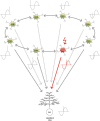Episodic Memories: How do the Hippocampus and the Entorhinal Ring Attractors Cooperate to Create Them?
- PMID: 33013334
- PMCID: PMC7511719
- DOI: 10.3389/fnsys.2020.559186
Episodic Memories: How do the Hippocampus and the Entorhinal Ring Attractors Cooperate to Create Them?
Abstract
The brain is capable of registering a constellation of events, encountered only once, as an episodic memory that can last for a lifetime. As evidenced by the clinical case of the patient HM, memories preserving their episodic nature still depend on the hippocampal formation, several years after being created, while semantic memories are thought to reside in neocortical areas. The neurobiological substrate of one-time learning and life-long storing in the brain, that must exist at the cellular and circuit level, is still undiscovered. The breakthrough is delayed by the fact that studies jointly investigating the rodent hippocampus and entorhinal cortex are mostly targeted at understanding the spatial aspect of learning. Here, we present the concept of an entorhinal cortical module, termed EPISODE module, that could explain how the representations of different elements constituting episodic memories can be linked together at the stage of encoding. The new model that we propose here reconciles the structural and functional observations made in the entorhinal cortex and explains how the downstream hippocampal processing organizes the representations into meaningful sequences.
Keywords: entorhinal cortex; episodic memory; grid cells; hippocampus; phase precession; plasticity; theta phase skipping; theta sequences.
Copyright © 2020 Kovács.
Figures






Similar articles
-
Sequence Memory in the Hippocampal-Entorhinal Region.J Cogn Neurosci. 2020 Nov;32(11):2056-2070. doi: 10.1162/jocn_a_01592. Epub 2020 Jun 12. J Cogn Neurosci. 2020. PMID: 32530378
-
Episodic memory: Neuronal codes for what, where, and when.Hippocampus. 2019 Dec;29(12):1190-1205. doi: 10.1002/hipo.23132. Epub 2019 Jul 23. Hippocampus. 2019. PMID: 31334573 Review.
-
How do spatial learning and memory occur in the brain? Coordinated learning of entorhinal grid cells and hippocampal place cells.J Cogn Neurosci. 2012 May;24(5):1031-54. doi: 10.1162/jocn_a_00200. Epub 2012 Jan 30. J Cogn Neurosci. 2012. PMID: 22288394
-
The hippocampus and related neocortical structures in memory transformation.Neurosci Lett. 2018 Jul 27;680:39-53. doi: 10.1016/j.neulet.2018.05.006. Epub 2018 May 4. Neurosci Lett. 2018. PMID: 29733974 Review.
-
Time cells in the human hippocampus and entorhinal cortex support episodic memory.Proc Natl Acad Sci U S A. 2020 Nov 10;117(45):28463-28474. doi: 10.1073/pnas.2013250117. Epub 2020 Oct 27. Proc Natl Acad Sci U S A. 2020. PMID: 33109718 Free PMC article.
Cited by
-
Emotional interference and attentional bias in compulsive sexual behaviors disorder - An fMRI study on heterosexual males.J Behav Addict. 2024 Jul 4;13(3):791-806. doi: 10.1556/2006.2024.00033. Print 2024 Oct 4. J Behav Addict. 2024. PMID: 38967992 Free PMC article.
-
Cardiovascular Endurance Modifies the Link between Subjective Sleep Quality and Entorhinal Cortex Thickness in Younger Adults.Med Sci Sports Exerc. 2021 Oct 1;53(10):2131-2139. doi: 10.1249/MSS.0000000000002697. Med Sci Sports Exerc. 2021. PMID: 33988545 Free PMC article.
-
Ring Attractors as the Basis of a Biomimetic Navigation System.Biomimetics (Basel). 2023 Sep 1;8(5):399. doi: 10.3390/biomimetics8050399. Biomimetics (Basel). 2023. PMID: 37754150 Free PMC article.
-
Relevance of a Novel Circuit-Level Model of Episodic Memories to Alzheimer's Disease.Int J Mol Sci. 2021 Dec 31;23(1):462. doi: 10.3390/ijms23010462. Int J Mol Sci. 2021. PMID: 35008886 Free PMC article.
-
Structural brain differences in school-aged children who are HIV-exposed uninfected.BMC Med. 2025 Aug 26;23(1):496. doi: 10.1186/s12916-025-04332-3. BMC Med. 2025. PMID: 40859302 Free PMC article.
References
LinkOut - more resources
Full Text Sources
Research Materials

